________________________________________________
RA Kris Millegan@1999-text
![]()
________________________________________________

What A Long Strange Trip It's Been
" . . . these same secret societies are behind it all," my father said. Now, Dad had never spoken much about his work.
You see, my Daddy was a — spy.
He entered into the "intel" world in the late thirties, later, he was OSS and G-2. During the early fifties he was the CIA's Branch Chief, Head of East Asia Intelligence Analyst Office. I spoke Dutch and Malay before English, whilst my family accompanied my "businessman" father to Indonesia in the early 1950s. That my father had worked for the government was no secret, but it just wasn't everyday conversation.
So one day, when my dad sat me down, I had very little to relate to when he very soberly and in rapid succession told me, "the Vietnam War is about drugs" and "these secret societies are behind it."
He then really laid one on me.
"Communism is all a sham, these same secret societies are behind it all."
"Hunh???"
I really couldn't relate. The only "secret society" I knew of was the Mafia and my teachers had been stuffing me under desks because the "commies" were going to bomb us. And since it was the sixties—and I was a teenager with my hair growing longer—I just tossed it off as my dad's way of having an anti-drug chat and went on with life.
Many years later I finally had some understanding of what my dad was talking about and—boy—do I wish I had asked some questions.
Like, was he was talking about The Order of Skull and Bones?
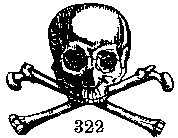
Skull and Bones, the pirates flag, a poison warning—an icon of death—an interesting symbol for what some say is merely a Yale 'frat' club. Just some college kids and their bizarre hazing humor—having fun.
For almost 170 years that grimacing visage and code of "strict secrecy" has fostered many questions.
What is Skull and Bones?
The Order of Skull and Bones is the oldest of several senior secret societies that are unique to Yale University. The "Order" was founded in 1832 by William Huntington Russell and Alphonso Taft. Many historians claim the group appeared as a direct result of the de-secretizing of America's oldest Greek-letter college secret society, Phi Beta Kappa.
Phi Beta Kappa had been "founded with impressive ritual and high solemnity" on Thursday, Dec 5, 1776, at William and Mary College, in Williamsburg, Virginia. A few years later in April of 1780, at Goshen, Connecticut, four students were "initiated into Phi Beta Kappa." Later on November 13, the official foundation meeting was held at Yale. "Three weeks and a day later" the chapter at William and Mary came to "an end" due to the threat of a British invasion during the War of Independence. Thus making the group at Yale the oldest existent chapter.
New England was going through a transformation from the strict puritanical Calvinist outlooks toward a more secular, scientific worldview. The revolutionary fervor and factionalization of the War of Independence had been sandwiched between a series of religious revivals that swept through the countryside like wildfires. During the first years of our Republic there was a big Illuminati conspiracy scare and a generation later an anti-Masonic hysteria that developed into a political force. The first national party convention—by any party, in the US—was held by the Anti-Mason party, in 1832.
Many people, including, John Quincy Adams, who was elected to Congress on an Anti-Mason/Whig ticket, were publicly campaigning against the secrecy of Phi Beta Kappa.
Phi Beta Kappa dropped its secret society aspect in 1832 and became an "open honorary organization," and "[in] protest, apparently, William H. Russell, valedictorian of 1833, got Alphonso Taft and thirteen other members of '33 to form what is now perhaps the most famous secret society in the United States."
From the very beginning Skull and Bones encountered resentment from fellow students. The faculty sent warning letters to the parents of early initiates. Even amid this controversy the chapter persisted and flourished, and by 1884 two other senior secret societies at Yale had been formed: Scroll and Key, and Wolf's Head. Also, Phi Beta Kappa had been revived after disappearing in 1871.
One old Yale tradition is "that 'Bones’ is a branch of a university corps of Germany, in which country, General Russell spent some time before graduation." During an infamous break-in by the "Order of File and Claw", on September 29, 1876 into the "Tomb"—the windowless "Bones"-owned and -built meeting house—the walls were seen to be "adorned with pictures of the founders of Bones at Yale, and of the members of the society in Germany, when the Chapter was established here in 1832."
In the cellar, the "File and Claw" raiders found a small room, with an "always-burning lamp" and "a dilapidated human skull." Upstairs three rooms were found, a lodge room with its walls covered in black velvet, a table with skull and crossbones, and the "sanctum sanctorum," room number 322, "furnished in red velvet" and on the wall a star with a finger pointing to it.
The "Order of File and Claw" also reported "an old engraving representing an open burial vault, in which on a stone slab, rest four human skulls, grouped around a fool's-cap and bells, an open book, several mathematical instruments, a beggar's scrip, and a royal crown. On the arched wall above the vault are the explanatory words, in Roman letters, 'We War Der Thor, Wer Weiser, We Bettler Oder Kaiser?' and below the vault is engraved, in German characters, the sentence; 'Ob Arm, Ob Beich, im Tode gleich,''.
"Who was the fool, who the wise man, beggar or king?
Whether poor or rich, all's the same in death."
This closely resembles the initiation into the Degree of Regent for the Bavarian Illuminati. "This degree was conferred only on such persons as by high intellectual attainments, social position, and tried fidelity, were considered capable of advancing the objects of the Order. The place of reception consisted of three rooms." One of these room was "hung with red," the "first room was set aside for preparation; it was hung with black, and in its centre, on a platform, stood a complete human skeleton, at whose feet, lay a crown and a sword. The candidate was led into this room; his hands were manacled, and he was left alone for a little while, during which time be could hear the conversation: carried on in the middle room. Who has brought this slave hither?—He came and knocked. What does he seek?—Freedom; he beseeches you to free him from his bonds.' Why does he not apply to those who have bound him?—They will not set him free; his servitude benefits them. Who has made him a slave?—Society, the State, false Religion. . . . Does he respect persons? Ask him who was the man whose skeleton be sees before him; was he a king, nobleman, or beggar?—He does not know; he only knows, that he was a man like one of ourselves. He wants only to be a man. Then let him be introduced. The candidate was then brought into the middle, and finally into the last room, and after some more catechising, invested with the dress of the Regent."
Is Skull and Bones an Illuminati group?
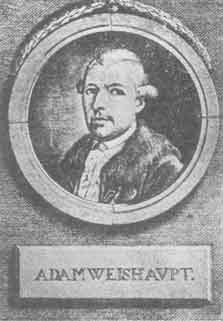
Some historians dispute any link between the Bavarian Illuminati and Phi Beta Kappa, and thus Skull and Bones. The argument is that Adam Weishaupt didn't form his group until May of 1776 and that in the ensuing six months there wasn't enough time for communication and that there was very "little in common between the Bavarian philosopher and the five boys" whom founded Phi Beta Kappa.
However, other researchers assert quite plainly that Phi Beta Kappa is the "Bavarian Illuminati, ... spread to America"; and "the Masonic Order probably influenced the founding of the Society at William and Mary."
In the late 1700s, ocean travel between Europe and America required a two to three month journey. It has been reported that Weishaupt began "canvassing" members for his order in 1774. He was a zealous member of the Lodge of Eclectic Masonry in 1775,—The Lodge Theodore of Good Consul,—along with people who became members of the Bavarian Illuminati. And even though, the sect was suppressed by the Bavarian government in 1788, there are accounts of the Illuminati's survival. Weishaupt, himself, lived until November 1830. Many of the Illuminati's early members were drawn from the charismatic professor's fellows and students. Weishaupt himself stated:
"The first task of the Association must therefore be to form the young members. As these multiply and advance, they become the apostles of beneficence, and the work is now on foot, and advances with a speed encreasing[sic] every day. The slightest observation shows that nothing will so much contribute to increase the zeal of the members as secret union."
There had been other secret, semi-secret and open college societies before Phi Beta Kappa, but these had usually had Latin names. The "five boys" who started Phi Beta Kappa were unknown for many years and the main founder was known as just the "young 'Hellenist."" Weishaupt—who rebelled against the Jesuit, Roman Catholic, Latin-speaking "power-structure" of his day—had a great fondness of things "Greek." In the Illuminati he went by Spartacus, the Greek slave who led the revolt against the Romans. All Illuminati members were given "new" names, mostly Greek, similar to Phi Beta Kappa and Skull & Bones members.
Who is in Bones?
Every year on a Thursday in May fifteen juniors are 'tapped"—initiated into next year's group. There have been a few irregular initiations and member years—usually because of war. Around 2,500 people have been members, mostly white males from old-line inter-related, wealthy New England families. Bundy, Bush, Ford, Goodyear, Harriman, Heinz, Jay, Kellogg, Lord, Lovett, Perkins, Phelps, Pillsbury, Pinchot, Rockefeller, Sloane, Stimson, Taft, Vanderbilt, Weyerhaeuser, and Whitney, are some of the names on the Skull and Bones roster. Minorities were brought in during the 1950's and female initiates were allowed into the Order in 1991.
Members of Order of Skull and Bones have had a great impact upon our society. "They" have friends in very high and—very low places. They occupy key positions in the worlds of commerce, communications , diplomacy, education, espionage, finance, law and politics. Their impact on professional associations and the philanthropical fortune-holding/controlling foundations has been very profound.
There have been two Skull and Bones Presidents—with a possible third, George W. Bush(S&B 1968), looming on the horizon; at least ten Senators; two Chief Justices of the Supreme Court and many U.S. representatives and state governors. "Bonesmen" have held a myriad of lesser appointed posts and positions, with a particular affinity for Secretary of War/Defense; diplomatic posts to Europe, Russia, China and the Philippines; and in the national security state/intelligence apparatus.
For some understanding of how "they" work let us look at the two U.S. presidents and their friends and families.
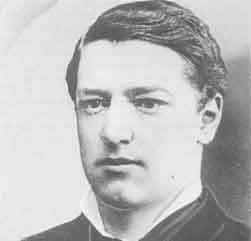
Young WH Taft at Yale
William Howard Taft(S&B 1878) is the only man who has served as both President and Chief Justice of the United States.

His father, Alphonso Taft (S&B co-founder 1833) was appointed Secretary of War by President Ulysses Grant, and later U.S. Attorney General. As Attorney General, Alphonso helped fashion the commission that decided who won the 1876 election. The commission found in favor of Rutherford B. Hayes, a member of Delta Kappa Epsilon, (DKE), originally a junior secret society at Yale, and the only national Greek letter fraternity initially founded at Yale. In 1882, Alphonso was appointed U.S. Minister to Austria-Hungary. He then moved to Russia for two years, leaving in 1886. He died in 1891.
His son, William Howard Taft, appointed by President McKinley, to be the first civil governor of the Philippines, displaced a disgruntled General Arthur MacArthur (General Douglas MacArthur's father) who had been the military governor. Teddy Roosevelt (DKE), who became president after McKinley’s assassination, appointed Taft to serve as Secretary of War (1904-08). While Secretary, he was the "master overseer and troubleshooter" for the Panama Canal; provisional governor of Cuba; and acting Secretary of State, while the Secretary of State John Hay was ill.

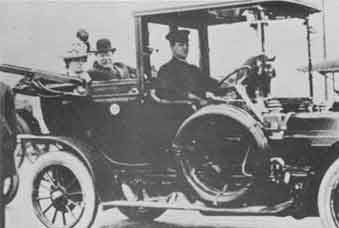
William Taft was elected President of the United States in 1909. He had the last cow and the first official automobile at the White House. During his administration, lawmakers sent Constitutional amendments to the states which provided for the direct election of Senators and a Federal Income tax. The foundation for the Federal Reserve System was laid during Taft’s administration and was signed into law furtively by his successor, Woodrow Wilson on Christmas Eve 1913. W. H. Taft was appointed Chief Justice of the Supreme Court by President Harding in 1921, and served until his death in 1930.

WH Taft and Family, inluding two future S&B members Robert and Charles.
President Taft made Henry L. Stimson (S&B 1888) his Secretary of War (1911-13). Stimson was appointed to high government posts by seven presidents. He was Governor General of the Philippines (1926-1928), Secretary of State under President Herbert Hoover (1929-1933) and Secretary of War under Presidents Franklin Delano Roosevelt and Harry S. Truman (1940-1946). He was "ultimately responsible" for the internment of Japanese-American citizens in WWII and oversaw the Manhattan Project, America’s atomic bomb program. Stimson also took credit for swaying Truman into dropping "the bomb" on Japan.
Henry groomed a generation of "cold warriors," in what was known as "Stimson's Kindergarten". Among Stimson’s students were General George C. Marshall, John J. McCloy, Dean Acheson (DKE), three "Bonesmen" from the Bundy family, and Robert A. Lovett (S&B 1918).
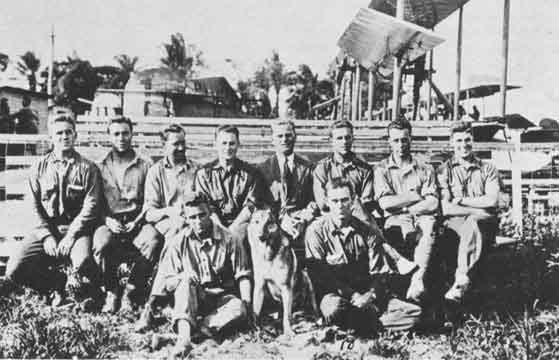
The "Yale Flying Unit"
Front Row: Wellsey Laud Brown and Henry P. Davison (S&B 1920)
Back Row:
John Vorys(S&B 1918), Artemus Gates(S&B 1918), Albert Dilman, Jr., Allan Ames(S&B 1918), David McCulloh, F Trubee Davison(S&B 1918), R Lovett(S&B 1918) & E. Gould
Arthur Schlesinger, Jr., wrote, "These men helped establish a distinguished network connecting Wall Street, Washington, worthy foundations and proper clubs. The New York and legal community was the heart of the American Establishment. Its household deities were Henry L. Stimson and Elihu Root* ; its present leaders, Robert A. Lovett and John J. McCloy; its front organizations, the Rockefeller, Ford and Carnegie foundations and the Council on Foreign Relations (CFR). " [* T. Roosevelt's Secretary of War—after W.H. Taft—and Stimson's senior law partner]
Robert A. Lovett was Assistant Secretary of War for Air (1941-1945), Secretary of Defense (1951-53), and a leading member of the CFR. Until his death in 1986, Lovett was one of the "most powerful men in the United States for nearly 40 years."
And as a partner in the investment house of Brown Brothers, Harriman, Lovett had connections to another interesting group of "Boodle Boys" ( an old slang term for members of the Order of Skull and Bones.)
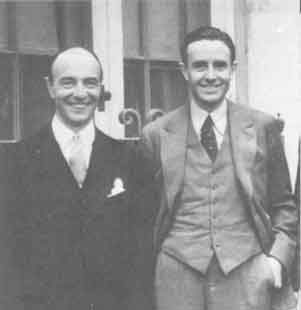
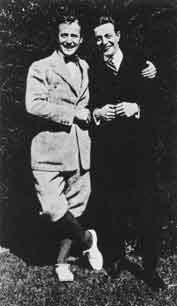
R Lovett and A Harriman in1936 R. Harriman and R. Lovett -1919
The fathers of W. Averell Harriman (S&B 1913) and Lovett were both executives for Union Pacific Railroads. Robert and the Harrimans were childhood friends.
In 1919, Averell Harriman founded WA Harriman and Company, a merchant investment house, now Brown Brothers, Harriman. Harriman took the reins of Union Pacific in 1932 serving as chairman of the board of untill 1942.
Averell had a lifelong interest in Russia, first visiting there in 1899. His last visit at age 91 was in 1983. Averell invested in the USSR soon after the revolution in defiance of federal laws and regulations. The investment firms, Guaranty Trust and Brown Brothers, Harriman—both dominated by "Bonesmen"—were involved in the early financing of Communist Russia. They financed industries, established banks and developed oil and mineral resources.
Later, as Minister to Great Britain in charge of Lend-Lease for Britain and Russia, Harriman created a program, that shipped entire factories into Russia and—according to some who were involved in the deal—was responsible for the transfer of nuclear secrets, plutonium and U.S. dollar printing plates to the USSR.
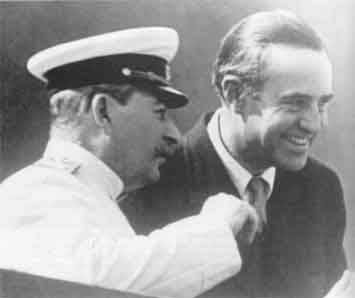
Harriman and Stalin
Harriman was the US Ambassador to the Soviet Union from 1943 to1946) and was a presidential secret envoy to Soviet leaders Stalin, Krushchev, Brezhnev and Andropov.
After World War II, he served as Secretary of Commerce (1946-48), special assistant to President Truman, and the U.S. representative at NATO meetings.
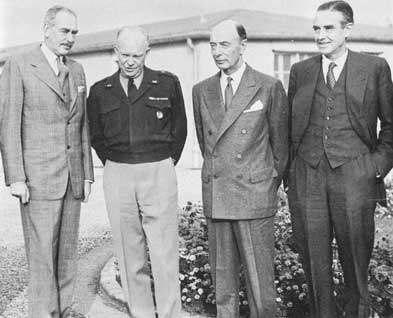
Secretary of State Dean Acheson(Scroll & Key), Ike, Secretary of Defense R Lovett
and Mutual Security Administration Director W. Harriman-11/51
In 1951, Averell became the Director of the Mutual Security Agency. Working with his fellow "Bonesman" Robert Lovett, who was Secretary of Defense and who had chaired the Lovett Committee in 1947, to organize US intelligence activities, they created a framework of national security apparatus belli, with "organization[s] of covert operations and 'psychological warfare.' "
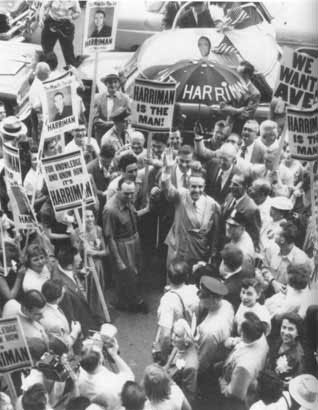
Harriman served a term as the Governor of New York (1954-58) and went on to dominate the Democratic national party as its "elder statesman" for the rest of his life.
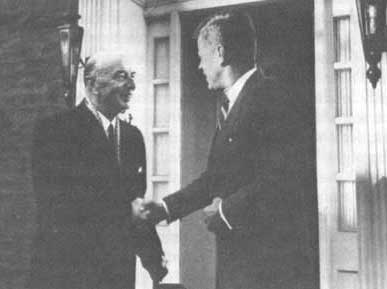
Robert Lovett, was asked by incoming President Kennedy to be Secretary of Defense or Treasury, he declined. But Lovett did suggested his friends, C. Douglas Dillon, investment executive and diplomat; Dean Rusk, Rockefeller Foundation president; and Robert MacNamara of Ford. These three became Treasury Secretary, Secretary of State and Secretary of Defense—the administration's most "important policy making positions"—and some of the "architects of the Vietnam War."

During the Vietnam conflict Harriman served in the State Department as Ambassador at Large for Presidents Kennedy and Johnson. He served as Under Secretary of State for Asia (1961-1963) and Under Secretary of State for Political affairs (1963-65), and led peace negotiations with North Vietnam in 1968.
"Stimson's Kindergarten" graduates, William Bundy (S&B 1939) and his brother McGeorge Bundy (S&B 1940), from their positions in the CIA, Department of Defense, the State Department and as Special Assistants to Presidents Kennedy and Johnson, exercised significant impact on the flow of information and intelligence during the Vietnam "police action."
William Bundy went on to be editor of Foreign Affairs, the influential quarterly of the Council on Foreign Relations (CFR). McGeorge became president of the Ford Foundation.
Two partners of WA Harriman and Co.' were Prescott Bush (S&B 1917) and his father-in-law, George Herbert "Bert" Walker. There were many other "Bones" directors and partners, including three from Prescott's class of 1917.
Bert Walker inherited a St. Louis dry-goods import and wholesale business. In 1900, he a started a banking and investment firm named the GH Walker and Company. Walker’s family had developed many international banking contacts and he helped organize the 1904 St. Louis World's Fair. A wheeler-dealer, Walker was known as the "power behind the throne" in local Democratic politics.
In 1919, Prescott Bush moved to St. Louis after accepting a job offer from Wallace E. Simmons (S&B 1890) in his railroad equipment company. That autumn Prescott met Dorothy, Bert Walker's daughter. That same year, Averell—who needed someone with strong international financial dealings—implored upon Bert to organize The WA Harriman & Co. Averell's brother, Roland "Bunny" Harriman (S&B 1917), was co-owner. Percy Rockefeller (S&B 1904) was a founding financial sponsor and director.
Prescott and his young family went to Connecticut in 1925,where he worked at the Harriman-controlled US Rubber Corp. Then, in 1926, his father-in-law Bert, president of WA Harriman & Company, made Prescott a vice-president. After the firm merged with Brown Brothers and became Brown Brothers, Harriman, Prescott was the managing partner.
On October 20 of 1942, ten months after Pearl Harbor, the US government ordered the seizure of "all the capital stock of the Union Banking Corporation, a New York corporation," by the US Alien Property Custodian. The government order stated "all of which shares are held for the benefit of … members of the Thyssen family, [and] is property of nationals … of a designated enemy country…" Prescott was a director and shareholder in the bank.
Averell, Bert and Prescott—using Union Banking, the Hamburg-Amerika Line and other fronts and holding companies—were directly involved in the build-up of Nazi Germany. Corporate lawyer and diplomat, John Foster Dulles, his brother, OSS and CIA spymaster, Allen Dulles, and others helped supply the Third Reich with capital, financial arrangements and asset management services.
This whole arrangement was kept very quiet, marked by only a small notice in the NY Times—years later—on Dec 16, 1944: "The Union Banking Corporation, 39 Broadway, New York has received authority to change its principal place of business to 120 Broadway." No mention was made of the fact that the property had been seized for trading with the enemy, or that 120 Broadway was the Alien Property Custodian's address.
And no 'fuss' was made at all, Prescott, later a US Senator, was still a partner in Brown Brothers, Harriman and held directorships for various companies, such as CBS, Dresser Industries, Pan-American Air, Prudential, and U.S. Guaranty and Trust.

An official signature for Brown Brothers Harriman & Co. c. 1931
Some other Skull and Bones partners
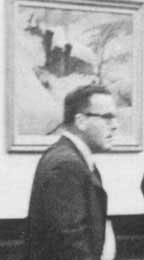

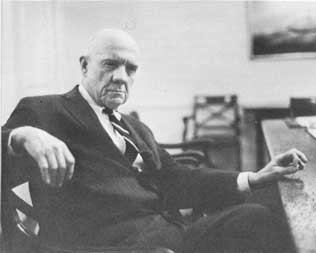
JB Madden S&B1941 Lawernce G. Tighe S&B 1941 Stephen Y Hord S&B1921
Trustee for Russell Treasurer of Yale In charge of Chicago office
Trust Assoc
Prescott had another secret, in May of 1918, he and some other "Bonesmen", had stolen Geronimo's skull from the Fort Sill Army Base in Oklahoma. In the fall of 1983, Ned Anderson, Tribal Chairman of the San Carlos Apache Tribe attempted to have the remains of Geronimo returned to his tribe's custody. A newspaper story was written about his search and the Army’s resistance towards his quest. Soon thereafter, an "informant provided Anderson with photographs of the stolen remains, and a copy of a Skull and Bones log book in which a 1918 grave robbery had been recorded. The informant said that Skull and Bones members used the pilfered remains in performing some of their Thursday and Sunday night rituals, with Geronimo's skull sitting out on a table in front of them."
" … from a Skull and Bones Society internal history entitled Continuation of the History of Our Order for the Century Celebration, 17 June 1933, by The Little Devil of D'121.
"oFrom the war days [W.W. I] also sprang the mad expedition from the
School of Fire at Fort Sill, Oklahoma, that brought to the T[omb] its
most spectacular "crook,'' the skull of Geronimo the terrible, the
Indian Chief who had taken forty-nine white scalps. An expedition in
late May, 1918, by members of four Clubs [i.e. four graduating-class
years of the Society], Xit D.114, Barebones, Caliban and Dingbat, D.115,
S'Mike D.116, and Hellbender D.117, planned with great caution since in
the words of one of them: "Six army captains robbing a grave wouldn't
look good in the papers.'' The stirring climax was recorded by
Hellbender in the Black Book of D.117: "... The ring of pick on stone
and thud of earth on earth alone disturbs the peace of the prairie. An
axe pried open the iron door of the tomb, and Pat[riarch] Bush entered
and started to dig. We dug in turn, each on relief taking a turn on the
road as guards.... Finally Pat[riarch] Ellery James turned up a bridle,
soon a saddle horn and rotten leathers followed, then wood and then, at
the exact bottom of the small round hole, Pat[riarch] James dug deep and
pried out the trophy itself.... We quickly closed the grave, shut the
door and sped home to Pat[riarch] Mallon's room, where we cleaned the
Bones. Pat[riarch] Mallon sat on the floor liberally applying carbolic
acid. The Skull was fairly clean, having only some flesh inside and a
little hair. I showered and hit the hay ... a happy man....''
After many tries Ned finally met with Jonathan Bush (S&B 1953] brother of then vice-president George Herbert Walker Bush (S&B 1948, DKE) in September 1986. Jonathan told Anderson obliquely "that he would get what he had come after" and said come back tomorrow. Tomorrow never came—the meeting was postponed.
"Bones" attorney Endicott Peabody Davison (S&B 1945) of the law firm Winthrop, Stimson, Putnam, and Roberts was called in. After some delay another meeting was held. Davison brought a display case—resembling the one Ned had a photo of—and a skull. The skull was different and appeared to be that of a child.
According to a 1988, Washington Post article, lawyer Davison wanted the Apache leader to sign an agreement that disallowed "anyone in association with us to make or permit any publication in connection with this transaction.'' Anderson refused. Davison claimed that "the Order's own history book is a hoax." However during the negotiations with Anderson, Davison never gave up the stipulation that "Anderson give up his copy of the book." Ned refused the proffered skull and signed nothing.
The private response from Skull and Bones members is that—if anything at all—Prescott was "conned' into purchasing a fake Geronimo skull and they point to reports of an archivist at Fort Sill who says the grave had been "moved … several years earlier."
Prescott's "alleged" skull theft and his "trading with enemy" were unknown publicly and had no bearing when he ran for Senator in 1950, but last minute revelations of his "contacts with birth controllers" … "cost him the election ... " (Yale and many of the Skull & Bones’ family have been at the forefront of the "race-science movement"—a whole story in itself. Yale economist Irving Fisher (S&B 1888), was the founder of the American Eugenics Society.)
In 1952, Eisenhower—an avid golfer—was running for President, having beaten Robert Alphonso Taft (S&B 1910) for the Republican nomination amidst fisticuffs and the first fully televised convention. Prescott a past president of the United States Golf Association was one of Ike's favorite golfing partners. Prescott's father-in-law, Bert, had also served as president of the USGA and in 1922, initiated an amateur golf tournament between the United States and Great Britain and Ireland. Walker donated the trophy and the newspapers christened it the "Walker Cup."
Prescott Bush won a special election—with Ike's help—in 1952, and became the senior US Senator from Connecticut. He served on the Armed Services Committee and helped to keep Connecticut’s huge defense contractors busy.

Roland Harriman, Prescott Bush, Knight Woolley and R. Lovett - all S&B and senior Partners at Brown Brothers Harriman - 7/64
Leaving the Senate, in 1962, Prescott rejoined Brown Brothers, Harriman and stayed involved in his family's business, political and social life. He was very instrumental in his son's business and political careers. He passed away in 1972, before he saw his son George Herbert Walker Bush elected to be the second US president from the foreign-based secret society, the Order of Skull and Bones.
But there was more to Prescott than meets the resume.
Prescott Bush had been an operative for Army Intelligence during World War I. He was a liaison to the British and some say he was trained by famous Stewart Menzies, WWII head of the British secret service.
Gordon Gray (another one of Prescott's golfing partners) was the first director of the Psychological Strategy Board, having been installed by the "Harriman security regime" in the early 50's. Gray and his four elite Jupiter Island, Florida, neighbors Prescott Bush, Robert A. Lovett, C. Douglas Dillion and "Jock" Whitney, are, along the Dulles and Harriman brothers considered by some historians to be the "fathers of this permanent covert action monolith". The "secret government" in the shadowy realms of intelligence operations that cloaks its actions with cries of national security.
They created this modern wall of deniality for Eisenhower deep within the government-military-industrial complex—that Ike was later to regret. One of Gray's jobs, as Ike's National Security advisor, was "under the guise of 'oversight' on all US covert action, to protect and hide" the "cryptocracy."
"Gray's son, C. Bowden was President Bush's very helpful "soulmate'", "protector of the president, come what may", White House counsel. He helped to keep George "out of the loop," as George became embroiled in the evolving Iran-Contra scandal.
In 1954, H. S. Richardson, the maker of Vick's cough drops and Vapo-Rub, wrote in a letter to Senator Prescott Bush; "… I want to get your advice and counsel on a subject—namely what should be done with the income from a foundation, which my brothers and I are setting up…"
Eugene Stetson (S&B 1934), an assistant manager for Prescott Bush at Brown Brothers, Harrimans organized the H. Smith Richardson Foundation. The foundation participated in the MK-ULTRA, a CIA domestic covert psychological warfare operation and helped to finance the testing of psychotropic drugs, including LSD, at Bridgewater Hospital in Massachusetts in the 50's.
During the Iran-Contra operations, the H. Smith Richardson Foundation was a "private donors steering committee," working with the National Security Council to co-ordinate the Office of Public Diplomacy. This was an effort to propagandize the public in favor of and run cover for the Iran-Contra operations, and to coordinate published attacks on opponents of the program.
In 1962, Prescott founded the National Strategy Information Center, with his son, Prescott Bush, Jr. and William Casey, investment banker, OSS veteran —and future CIA director. The center, among other things, laundered funds for the dissemination of "CIA authored 'news stories' to some 300 newspapers."
Iran-Contra, Watergate are just two of the many scandals that allows glimpses into a "secret government" netherworld. Scandals used to deflect attention away from deeper corruption. A black and gray world where one sees many of the same faces and, yes, George HW Bush is/was in the loop. A deep cover in an alliance of oil and intelligence that has merged with another cabal—intelligence, the mob and drugs. "Drug trafficking" is now in the realm of "national security." There are excuses like—isn't it better that we do it, instead of someone else, and other spurious—whatever's handy hoodwinks and backstops. Here, one is dealing with an "intel" world where a big rule is to leave no fingerprints. Deniability—being out of the loop— are built into systems of overlapping agencies and groups that are used by this "secret government."
The assault upon the rights of American public through an unconstitutional War on Drugs has just been part of a directed cultural, economic, political and real warfare. There is no true public debate or public exposure. ABC's Peter Jennings does series of reports on CIA's shady money dealings—ABC is bought by Bush friend William Casey's influenced Capitol Cities—and the reports stop. Many a policing agency's bust is "compromised" by claims of national security; money and property are given back and get-out-of-jail-cards are routinely used—while us hoi polloi's lives are ruined. Exposes, reporters and agents are summarily squashed, ignored, dismissed, jailed and … killed.
A steady drumbeat of events and news stories is used to create fear and division within our society. The targeted racial realities and exploited fears of the drug trade and drug use are used to subdue many and disenfranchise all parts of the community. Along with the crack, came the reality-cop show "popularizing the police state." More laws, equals more criminals, more prisons, more controls and more corruption. And more money to be made … Prohibition brings higher prices. Competition can be "officially" weeded out and the public pays for anti-drug messages that entreats teens.
Drugs are a hard-metal cash crop. "Gold" from the ground—in some places it can be harvested three times a year. Drugs … is the biggest business on the planet.
But then, this game is not new and has been played before …
**